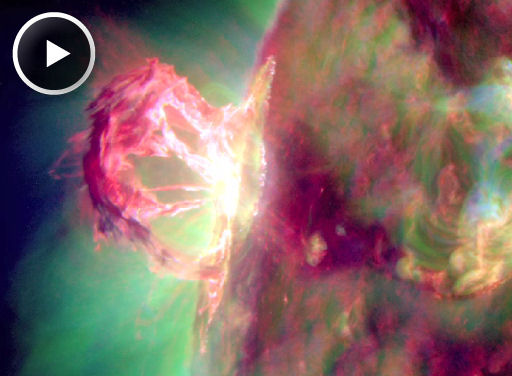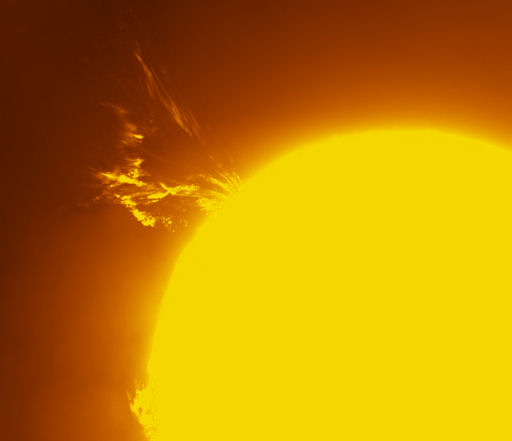SPECTACULAR EXPLOSION (UPDATED): Magnetic fields on the sun's northeastern limb erupted around 17:45 UT on April 16th, producing one of the most visually-spectacular explosions in years. NASA's Solar Dynamics Observatory (SDO) recorded the blast at extreme ultraviolet wavelengths:
The explosion, which registered M1.7 on the Richter Scale of solar flares, was not Earth-directed, but it did hurl a CME into space. Analysts at the Goddard Space Weather Lab have analyzed the trajectory of the cloud and found that it will hit NASA's STEREO-B spacecraft, the Spitzer space telescope, and the rover Curiosity en route to Mars. Planets Venus and Mars could also receive a glancing blow.
Using data from SDO, Steele Hill of NASA's Goddard Space Flight Center assembled a must-see movie of the event. It shows the explosion unfolding at 304Å, a wavelength which traces plasma with a temperature around 80,000 K.
Coverage of the blast was not limited to space telescopes. Amateur astronomers saw it, too. Jim Lafferty sends this picture from his backyard observatory in Redlands, California:
"Yesterday's prominence on the sun's eastern limb was was one of the largest in years---short lived, it was mostly gone in a few hours," says Lafferty. "It was a wonderful sight in the eyepiece and in the camera!"
more images: from Vahan Yeterian of Lompoc California; from John Minnerath of Crowheart, Wyoming; from John Stetson of Falmouth, Maine; from Thomas Ashcraft of New Mexico;

![]()
Solar wind
speed: 365.6 km/sec
density: 0.2 protons/cm3
explanation | more data
Updated: Today at 1629 UT
![]()
X-ray Solar Flares
6-hr max: B7 1129 UT Apr17
24-hr: C1 0815 UT Apr17
explanation | more data
Updated: Today at: 1600 UT
![]()
![]()
![]()
Daily Sun: 17 Apr 12
![]()
![]()
The source of yesterday's "spectacular explosion" is circled. It hardly looks capable of such a magnificent blast. Credit: SDO/HMI
![]()
![]()
![]()
Sunspot number: 86
What is the sunspot number?
Updated 16 Apr 2012
Spotless Days
Current Stretch: 0 days
2012 total: 0 days (0%)
2011 total: 2 days (<1%)
2010 total: 51 days (14%)
2009 total: 260 days (71%)
Since 2004: 821 days
Typical Solar Min: 486 days
Updated 16 Apr 2012
The Radio Sun
10.7 cm flux: 108 sfu
explanation | more data
Updated 16 Apr 2012
![]()
![]()
![]()
Current Auroral Oval:
![]()
Switch to: Europe, USA, New Zealand, Antarctica
Credit: NOAA/POES
![]()
![]()
![]()
Planetary K-index
Now: Kp= 2 quiet
24-hr max: Kp= 2 quiet
explanation | more data
![]()
Interplanetary Mag. Field
Btotal: 8.4 nT
Bz: 7 nT south
explanation | more data
Updated: Today at 1636 UT
![]()
![]()
![]()
Coronal Holes: 17 Apr 12
![]()
![]()
There are no large coronal holes on tthe Earthside of the sun. Credit: SDO/AIA.






